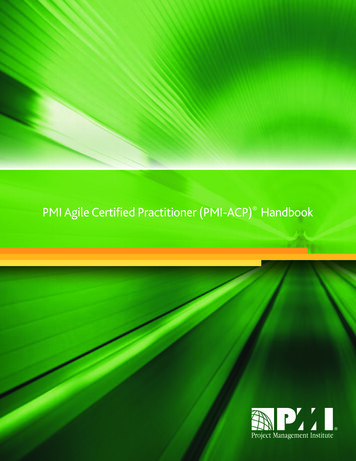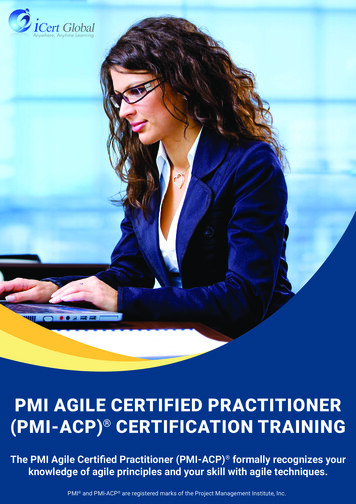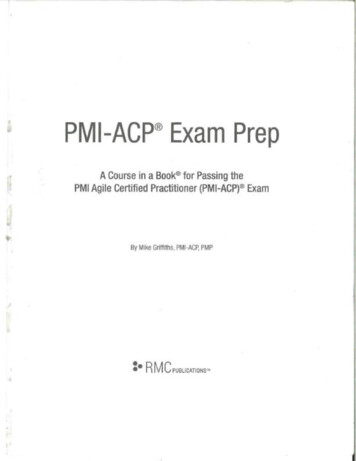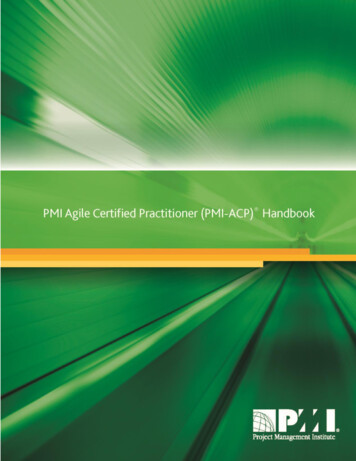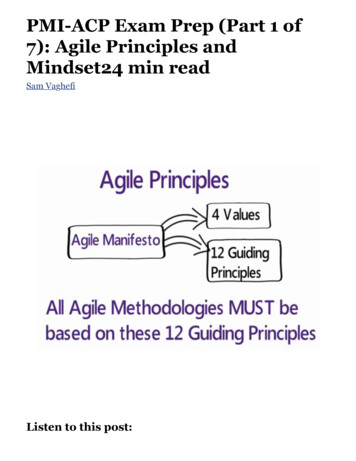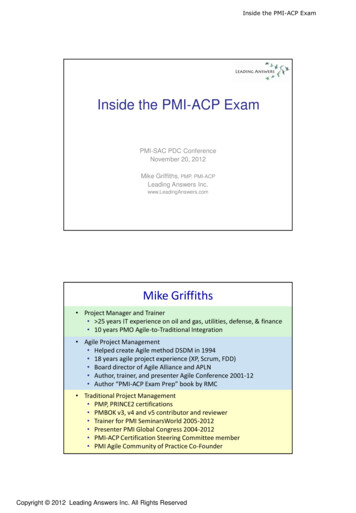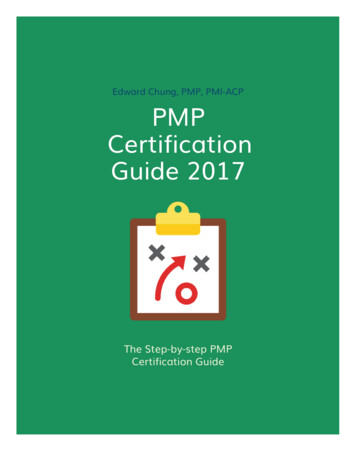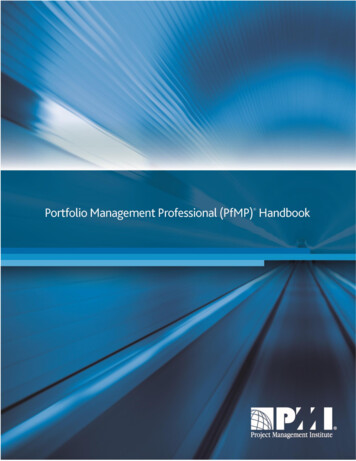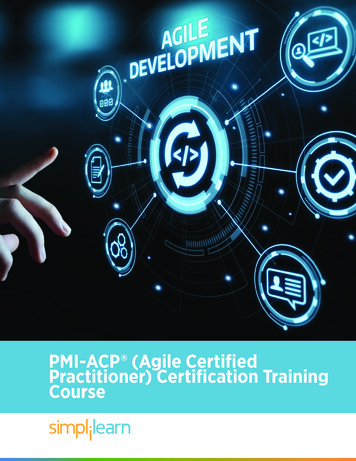
Transcription
PMI-ACP (Agile CertifiedPractitioner) Certification TrainingCourse
Table of Contents:Program OverviewCertification AlignmentProgram FeaturesCertification Details and CriteriaDelivery ModeCourse CurriculumPrerequisitesCourse End ProjectsTarget AudienceCustomer ReviewsKey Learning OutcomesAbout UsProgram Overview:This PMI-ACP (Agile Certified Practitioner) training will empower you to become a skilledagile professional with knowledge of a broad range of agile methodologies, includingScrum, Kanban, Lean, extreme programming, and test-driven development. This course isaligned to recent updates to the PMI-ACP exam, using the Agile Practice Guide as a newreference material. This course covers agile methodologies, tools, and techniques and theconcepts of the Agile Practice Guide, while providing real-life scenarios throughout.Program Features:55 hours of applied learning28 hours of instructor-led training27 hours of high quality content2 industry case study and 61 real life examples49 end-of-chapter quizzes5 simulation exams26 PDUs (self-paced learning) and 28 PDUs (instructor-led training)Delivery Mode:Online Bootcamp - Online self-paced learning and live virtual classroom
Prerequisites:To apply for the PMI Agile Certified Practitioner certification PMI, you should have:A secondary degree or higher degree2000 hours of general project management experience in the last five yearsAt least 1,500 hours of experience working on agile project teams during the last threeyearsTarget Audience:Project managersAgile team membersAssociate/assistant project managersTeam leads/managersProject executives/engineersSoftware developersAny professional aspiring to be a project managerKey Learning Outcomes:This PMI-ACP training course will enable you to:Understand the history of agile, including founding, evolution, core concepts and principlesDevelop a working knowledge of the agile principles of Scrum, Kanban, XP and TDDDevelop the expertise of implementing multi-iterative development models for any scale ofprojectsDevelop the ability to deliver high velocity stories and epicsDevelop the knowledge and skills required to clear the PMI-ACP certification exam along withthe requisite 21 PDUsCertification Alignment:Our ACP course is accredited by PMI. We are the registered training provider for this course.
Certification Details and Criteria:The PMI-ACP certification, provided by the Project Management Institute (PMI), is a globallyrecognized affirmation of an agile professional’s knowledge of agile principles and skills.It covers a wide variety of agile approaches, such as Scrum, Lean, Kanban, extremeprogramming (XP) and test-driven development (TDD). Professionals with the PMI-ACPcertification are in high demand because they help organizations become more responsive todynamics in the marketplace and thus more efficient, completing projects more quickly andeffectively.PMI-ACP Exam Application Process:Register to become a member of the Project Management Institute (PMI)Take our PMI-ACP Exam Prep Course to satisfy the required 21 contact hours (PDUs)education requirementSubmit your PMI-ACP application through the PMI website and pay the feeSchedule your exam with Pearson VUETake and pass the PMI-ACP ExamThe questions are broken down into 7 domains:Agile Principles and Mindset (16%)Value-driven Delivery (20%)Stakeholder Engagement (17%)Team Performance (16%)Adaptive Planning (12%)Team Performance (16%)Adaptive Planning (12%)Simplilearn Course Completion Criteria:Attend 85 percent of the course or one complete batchEarn a score of at least 60 percent on the course-end assessmentSuccessful evaluation of at least one project
Course Curriculum:Lesson 01 - Course IntroductionCourse IntroductionEligibility RequirementsCertification Fees and RenewalAbout Our CourseLesson 02 - Agile Principles and Mindset - Part 1Agile Principles and Mindset - Part OneIntroduction to AgileAgile Engineering PracticesThe Agile ManifestoAgile Manifesto ExplainedPrinciples of Agile ManifestoApplying the Principles of Agile ManifestoAgile Core Principles and PracticesBenefits of AgileProject Life Cycle CharacteristicsKey TakeawaysKnowledge Check
Lesson 03 - Agile Principles and Mindset - Part 2Agile Principles and Mindset - Part TwoAgile MethodologiesAgile MindsetWhere to Apply AgileMeaning of ScrumFeatures of ScrumThree Pillars of ScrumScrum RolesKey Terms of ScrumScrum MeetingsScrum: An Empirical ProcessExtreme ProgrammingExtreme Programming Practices - Part AExtreme Programming Practices - Part BRoles in Extreme ProgrammingProcess Diagram of XPCrystal MethodProperties of Crystal MethodKey Categories of Crystal Method - Part AKey Categories of Crystal Method - Part BDynamic Systems Development Method (DSDM)Basic Principles of AternPlanning Philosophy in DSDMDSDM TechniquesDSDM PhasesFeature-Driven DevelopmentAgile Project ManagementKey TakeawaysKnowledge Check
Lesson 04 - Value-Driven Delivery - Part 1Value-Driven Delivery - Part OneQuantifying Customer ValueTime Value of MoneyTime Value of Money: ExampleThe Financial Feasibility of ProjectsReturn on Investment ROINet Present Value (NPV)Net Present Value (NPV): ExampleInternal Rate of Return (IRR)Payback PeriodPayback Period: ExamplePrioritization of Functional RequirementsMoSCoWKano ModelRelative WeightingPrioritization of Non-Functional RequirementsRisk Management in AgileKey TakeawaysKnowledge CheckLesson 05 - Value-Driven Delivery - Part 2Value-Driven Delivery - Part TwoMinimal Viable ProductProject Planning Using MVPAgile ComplianceKey Drivers of Agile ComplianceIncremental DeliveryReview and FeedbackEarned Value ManagementEarned Value MetricsEarned Value Metrics: ExampleAgile Contracts: ComponentsAgile Contracting MethodsFixed-Price or Fixed-Scope ContractTime and Materials (T and M) ContractT and M with Fixed Scope and Cost CeilingT and M with Variable Scope and Cost CeilingBonus or Penalty ClausesRolling Agile ContractsTerms Used in Agile ContractsKey TakeawaysKnowledge Check
Lesson 06 - Stakeholder Engagement - Part 1Stakeholder Engagement - Part OneStakeholder EngagementProject CharterUnderstanding Stakeholder NeedsAgile WireframesUser StoryStory Card InformationAgile PersonasTheme and EpicAgile Story MapsCommunity and Stakeholder ValuesKey TakeawaysKnowledge CheckLesson 07 - Stakeholder Engagement - Part 2Stakeholder Engagement - Part TwoCommunity ManagementCommunication and Knowledge SharingSocial Media CommunicationInformation RadiatorsBurnup and Burndown ChartsKanban or Task BoardImpediment LogsCharacteristics of Information RadiatorsAgile ModelingActive ListeningKey Elements of Active ListeningGlobalization Diversity and Cultural SensitivityCultural Diversity Issues: RecommendationsAgile Facilitation MethodsAgile Negotiation and Conflict ManagementFive Levels of ConflictKey TakeawaysKnowledge Check
Lesson 08 - Team Performance - Part 1Team Performance - Part OneFeatures and Composition of Agile TeamsStages of Agile Team FormationHigh Performance TeamsGeneralizing SpecialistTeam ResponsibilitySelf-OrganizationKey TakeawaysKnowledge CheckLesson 09 - Team Performance - Part 2Team Performance - Part TwoAgile LeadershipBest Practices of Agile LeadershipManagement vs LeadershipServant LeadershipCoaching and MentoringAgile CoachingAgile Emotional IntelligenceTeam MotivationMaslow’s TheoryFrederick Herzberg's TheoryMcClelland's TheoryBoehm's TheoryTeam SpaceCo-Located TeamsDistributed TeamsCo-Located vs. Distributed TeamsOsmotic CommunicationTeam Collaboration and CoordinationCollaboration TechnologyCommunication Gap-Example OneCommunication Gap-Example TwoBrainstorming SessionsTeam VelocityVelocity-Example OneVelocity-Example TwoSample Velocity ChartVelocity-Example TwoAgile ToolsKnowledge Check
Lesson 10 - Adaptive Planning - Part 1Adaptive Planning - Part OnePlanning PhilosophyAligning Agile ProjectsRolling Wave PlanningTimeboxingBest Practices of TimeboxingAdvantages of TimeboxingAgile EstimationStory PointsAssigning Story PointsStory Points EstimationStory Points Estimation Scale: ExampleValue PointsIdeal DaysStory Points vs. Ideal DaysWideband Delphi TechniquePlanning PokerPlanning Poker: ExampleAffinity EstimationKey TakeawaysKnowledge CheckLesson 11 - Adaptive Planning - Part 2Adaptive Planning - Part TwoProject Size EstimationRelease PlanRelease Plan: ExampleIteration PlanTypes of Iteration PlanningIteration Lifecycle: ExampleRelease Plan vs. Iteration PlanAgile Product RoadmapBacklog Refinement - Part TwoValue-Based Analysis and DecompositionAgile Cone of UncertaintyVelocity VariationsSprint ReviewsSprint RetrospectivesMid-Course CorrectionsKey TakeawaysKnowledge Check
Lesson 12 - Problem Detection and Resolution - Part 1Problem Detection and Resolution - Part OneAgile Problem DetectionProblem Detection TechniquesFishbone DiagramFive Whys TechniqueControl ChartsLead Time and Cycle TimeKanbanKanban ProcessExample of Kanban BoardWork In ProgressManaging ConstraintsLittle’s LawEscaped DefectsAgile Problem SolvingKey TakeawaysKnowledge CheckLesson 13 - Problem Detection and Resolution - Part 2Adaptive PlanningMetrics and MeasuresBenefits of MetricsExamples of MetricsBaseline MetricsVariance and Trend AnalysisRisk Management Life CycleStep One-Risk IdentificationStep Two-Risk AssessmentStep Three-Risk Response StrategiesStep Four-Risk ReviewRisk LogRisk Burndown ChartRisk Profile GraphSpikeAgile Failure ModesAgile Coach Failure ModesTroubleshooting GuidelinesKey TakeawaysKnowledge Check
Lesson 14 - Continuous Improvement - Part 1Continuous Improvement - Part OneKaizenKaizen in AgileLeanDefining Waste Manufacturing and Software DevelopmentA Five Step Process to Becoming LeanValue Stream MappingAgile RetrospectivesCargo SmellsConducting a RetrospectiveBrainstorming TechniquesProcess Analysis TechniquesAgile Process TailoringProject Factors That Influence TailoringKey TakeawaysKnowledge CheckLesson 15 - Continuous Improvement - Part 2Continuous Improvement - Part TwoQuality in AgileBest Practices for Quality in AgileBest Practice One: Verification and ValidationBest Practice Two: Exploratory TestingBest Practice Three: Usability TestingBest Practice Four: Test-Driven DevelopmentTest-Driven Development AdvantagesAcceptance Test-Driven Development Cycle (ATDD)Best Practice Five: Continuous IntegrationBest Practice Six: Definition of DoneTesting Pyramid and QuadrantChecklist for Story CompletionAgile FlowchartAgile Spaghetti DiagramOrganizational Self AssessmentKey TakeawaysKnowledge Check
Course End Projects:Project 1: E-commerce Website Functionality CreationParticipants will learn how the three agile roles (Product Owner, Scrum Master, and Scrum Team)complement each other in a real-time project on Jira. This demo of an e-commerce website willhelp users understand and create backlogs, user stories, tasks, epics, and sub-tasks. It will alsoshow you how to manage multiple releases.Project 2: Smart WeatherYou will complete two industry-based tasks provided by the product owner of a new technologydivision. The projects involve creating a portal to provide weather-based services to multiple clients.The portal needs to pull the weather forecast from various public services so that the captured datacan be used for various purposes. Implementation of this project should be completed throughJIRA.Project 3:BigBucks Café, a leading chain of premium coffee shops, wants you to use weather data to regulateand manage its daily operations. As a Scrum Master, you need to resolve and create a prioritizedproduct backlog for the scrum team.Project 4:The world’s largest life insurance company, LeViva, wants to launch an app to serve its customers,and they would like to use the weather forecast. As a Scrum Master, you need to resolve and createa prioritized product backlog for the scrum team.
Customer Reviews:Bhagyaraj ChitothSenior Manager - Analytics - Global Risk Management at Anheuser-Busch InBevThe course instructor, Parul, is very knowledgeable and was ableto answer all our questions asked during the sessions. Her trainingstyle was impressive!Alok UpadyayTransformation Coach & Trainer SAFe Program Consultant (4.6) KMP CSP CSPO CSM Good experience learning about agile methodologies, tools andtechniques. The pointers and task-oriented games were amazinglyhelpful for understanding the key concepts.Rajesh NagwekarSenior Manager, Engineering Products at Kofax India Pvt LtdThe training content was modified as per my requirement. Allquestions were clarified and they were practical . The sessions werecompleted on time without missing any areas.Soumendra Kumar DasDirector - Projects at Cognizant Technology SolutionsI registered for the Agile Certified Practitioner (PMI-ACP) coursefrom Simplilearn. The content of the self-paced learning program isexcellent. The best part is that the subunits in each of the domainsare very well organized. Simplilearn does not just try to make youpass the examination, they prepare you in such a way that thefundamentals are clarified as well.
About Us:Simplilearn is the world’s #1 online bootcamp provider that enables learners throughrigorous and highly specialized training. We focus on emerging technologies and processesthat are transforming the digital world, at a fraction of the cost and time as traditionalapproaches. Over one million professionals and 2000 corporate training organizations haveharnessed our award-winning programs to achieve their career and business goals.For more information, please visit our lilearn is the world's #1 online bootcamp for digital economy skills training focused on helping peopleacquire the skills they need to thrive in the digital economy. Simplilearn provides outcome-based onlinetraining across technologies and applications in Data Science, AI and Machine Learning, Cloud Computing,Cyber Security, Digital Marketing, DevOps, Project Management, and other critical digital disciplines.Through individual courses, comprehensive certification programs, and partnerships with world-renowneduniversities, Simplilearn provides millions of professionals and thousands of corporate training organizationswith the work-ready skills they need to excel in their careers. Based in San Francisco, CA, and Bangalore,India, Simplilearn has helped more than one million professionals and 2,000 companies across 150 countriesget trained, acquire certifications, and reach their business and career goals. With over 1,000 live classeseach month, real-world projects, and more, professionals learn by doing at Simplilearn. Ongoing industryrecognition for the company includes the 2020 Aegis Graham Bell Award for Innovation in EdTech and the2020 Stevie Gold Award for Customer Service Success.India – United States – Singapore 2009-2019 - Simplilearn Solutions. All Rights Reserved.The certification names are the trademarks of their respective owners.
PMI-ACP Exam Application Process: Register to become a member of the Project Management Institute (PMI) Take our PMI-ACP Exam Prep Course to satisfy the required 21 contact hours (PDUs) education requirement Submit your PMI-ACP application through the PMI website and pay the fee Schedule your exam with Pearson VUE Take an
